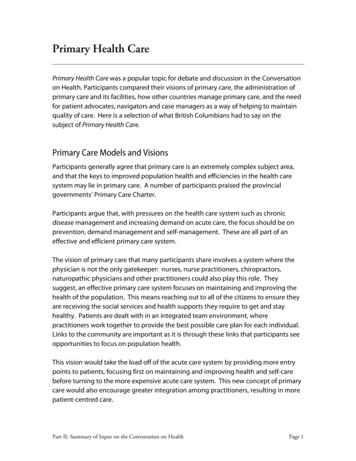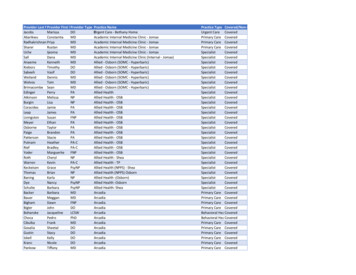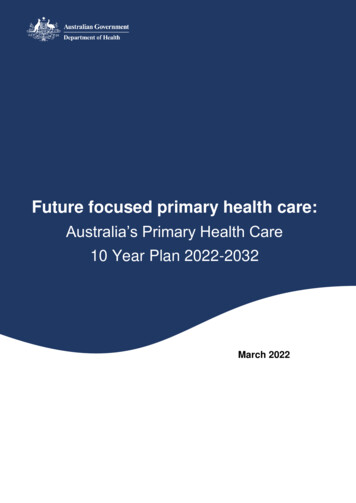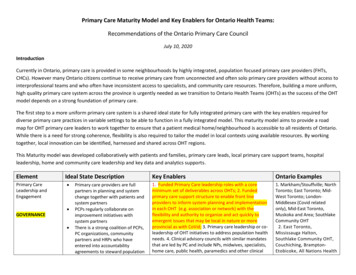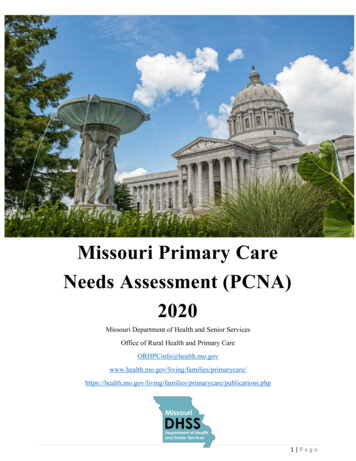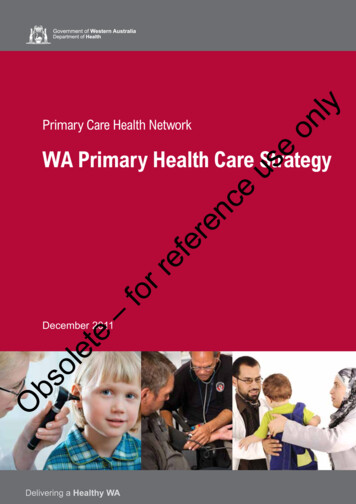
Transcription
onlyPrimary Care Health Network–forreferenceuseWA Primary Health Care StrategyObsoleteDecember 2011
onlyuseeforreferenc Department of Health, State of Western Australia (2011).olete–Copyright to this material produced by the Western Australian Department of Healthbelongs to the State of Western Australia, under the provisions of the Copyright Act 1968(C’wth Australia). Apart from any fair dealing for personal, academic, research ornon-commercial use, no part may be reproduced without written permission of the HealthNetworks Branch, Western Australian Department of Health. The Department of Healthis under no obligation to grant this permission. Please acknowledge the WA Departmentof Health when reproducing or quoting material from this source.bsSuggested CitationODepartment of Health, Western Australia. Primary Health Care Strategy. Perth:Health Networks Branch, Department of Health, Western Australia; 2011.Important Disclaimer:All information and content in this Material is provided in good faith by the WADepartment of Health, and is based on sources believed to be reliable and accurateat the time of development. The State of Western Australia, the WA Department of Healthand their respective officers, employees and agents, do not accept legal liabilityor responsibility for the Material, or any consequences arising from its use.
Primary Care Health Network WA Primary Health Care StrategyTable of 2132. Areas for reform2.1 Regional integration2.2 Information technology including eHealth2.3 Skilled workforce2.4 Infrastructure2.5 Financing and system performance1717171819193. Priority service delivery areas3.1 Aboriginal health3.2 Healthy ageing3.3 Mental health and drug and alcohol services3.4 Maternal and child health3.5 Oral health3.6 Chronic 1. Introduction1.1 Vision1.2 Purpose1.3 Definition of primary health care1.4 Context1.5 WA Health and primary health care in Western Australia1.5.1 Facilitating quality health service delivery1.5.2 Partnering with primary health care providers1.5.3. Providing primary health care services1.6 Common principles underlying the WA Primary Health Care Strategy1.7 Essential components of primary health care1.8 Strategy development4. Implementation29References30AppendicesAppendix 1: Definitions and GlossaryAppendix 2: Implementation issues identified during consultation333336Index of figuresFigure 1 Roles of WA Health in primary health careFigure 2 WA Health’s Health Services691
AcknowledgementsonlyThis document is the result of contributions from a number of organisations andindividuals from across WA Health, stakeholders in primary health care, professionalbodies and the community. It represents the collective expertise and continuedwillingness of the WA Primary Care Strategy Working Group members and theHealth Networks team to work collaboratively in the development of this document.useThe members of the Executive Advisory Group of the Primary Care Health Network arealso acknowledged for their support and expertise in overseeing the activities of theworking party and we thank them for their time and thoughts.eWA Primary Care Strategy Working Group members:Obsolete–forreferencMs Margaret Abernethy Senior Policy Officer, Child and Adolescent Health ServiceDr Scott Blackwell (Chair) Clinical Lead, Primary Care Health NetworkDr Andrew Briggs Senior Development Officer, Health Networks BranchMrs Pat Cambridge Manager, Health Network BranchMs Samantha Dowling Senior Policy Officer, WA GP NetworkMs Ros Elmes Executive Director, North Metropolitan Area Health ServiceMrs Maria Ferreira CarerAdjunct Associate Professor Kim Gibson Chair, Clinical Senate of Western Australia;and Adjunct Associate Professor of the School of Physiotherapy, Curtin UniversityMs Jenny Goyder Senior Development Officer, Health Networks BranchMr John Harvey President, Pharmaceutical Society of Western AustraliaDr Glen Koski General PractitionerProfessor Louis Landau Chair, Postgraduate Medical Council; and Director, MedicalWorkforceDr Peter Maguire General PractitionerMr Chris McGowan Chief Executive Officer, Silver ChainMr Mitch Messer ConsumerMs Sonia Michelon Program Officer, Health Networks BranchMs Rangi Pouwhare Manager, Office of Aboriginal HealthMrs Debra Salway Chief Executive Officer, WA GP NetworkMr Mark Slattery Manager, Health Networks BranchMs Suzanne Taylor Senior Development Officer, Health Networks BranchDr Simon Towler Chief Medical Officer, WA Department of HealthDr John van der Post Emergency Physician, Royal Perth HospitalProfessor Alistair Vickery Professor of General Practice, University of WesternAustralia; Chair, Osborne Division of General PracticeMs Melissa Vernon Area Director Primary Health and Engagement, Western AustralianCountry Health Service.2
Primary Care Health Network WA Primary Health Care StrategyForewordonlyI am pleased to present the WA Primary Health Care Strategy. This document outlinesa strategy for reform in primary health care which will establish a person-centred systemto improve health outcomes of Western Australians.useThe release of this document is the culmination of an intensive phase of research,discussion, development and consultation with stakeholders across the primary healthcare sector. Stakeholders were asked to provide feedback on a range of possiblestrategies and overwhelmingly called for a change in direction for primary health care.forreferenceThe WA Primary Health Care Strategy provides an opportunity for primary health careto ‘come of age’ as an equal partner with care provided in the hospital system, in anenvironment of mutual respect and trust. Robust primary health care services will notonly enhance the effectiveness of the hospital system, but will contribute to improvedhealth and quality of life for all Western Australians.An effective and equitable primary health care sector maximises linkages acrossCommonwealth, state, local government, non-government and private sector providers.WA Health has a key role to play in fostering effective partnerships, connections andintegration across all provider groups to improve the journey and outcome for peopleusing primary care health services.The WA Primary Health Care Strategy provides a comprehensive, relevant and effectiveblueprint for reform in Western Australia’s primary health care sector and aligns closelywith the key building blocks identified by the Commonwealth Government in its strategydocument, Primary Health Care Reform in Australia.1olete–I would like to acknowledge the invaluable contributions of the stakeholders who haveworked with the Primary Care Health Network since August 2008 to identify andexplore the major issues raised in this strategy.ObsKim SnowballDirector GeneralDepartment of HealthDecember 2011The use of the term “Aboriginal” within this document refers to both Aboriginaland Torres Strait Islander Australians.3
1. Introductiononly1.1 VisionBetter health for the people of Western Australia through integrated, accessible,high-quality primary health care.1.2 PurposeeuseThe purpose of the WA Primary Health Care Strategy (the Strategy) is to:describe the role of WA Health within primary health care in Western Australiaprovide a policy framework for WA Health to undertake statewide reform initiativesarticulate the importance of primary health care partnerships.forreferencThis document is relevant to all stakeholders within primary health care.1.3 Definition of primary health caree–The Australian Primary Health Care Research Institute defines primary health care as:“Socially appropriate, universally accessible, scientifically sound first level care providedby a suitably trained workforce supported by integrated referral systems and in a waythat gives priority to those most in need, maximises community and individual selfreliance and participation and involves collaboration with other sectors. It includes thefollowing:health promotionillness preventioncare of the sickadvocacycommunity development.”2bsoletPrimary health care is provided by an array of people including general practitioners,dentists, public health professionals, community health nurses, midwives, nursepractitioners, pharmacists, Aboriginal health workers, paramedics, allied healthprofessionals, and carers across the local, state and Commonwealth governmentsectors, non-government organisations and the private sector.OConsumers, carers, and the broader community are pivotal in the planning,implementation, and evaluation of primary health care.4
Primary Care Health Network WA Primary Health Care Strategy1.4 ContextonlyAround the world, primary health care is regarded as a major contributor to betterpopulation health. In fact, the World Health Organization has declared that “the ultimategoal of primary health care is better health for all”.3 It is now recognised internationallythat integration between hospital services and health care delivered by communitybased primary health care providers is critical to improving population health, reducinginequalities in health, and creating a seamless care pathway for health consumers.4,5useWA Health has recognised that reform is needed in the primary health care system at thelocal, state and Commonwealth level. A number of indicators point to the need for reform.forreferenceThese include:the growing prevalence of chronic disease1ongoing inequalities in health service delivery, particularly to Aboriginal Australians6the ageing population7service gaps and duplication in many areas8fragmentation in the primary health care sector.9While there have been a number of reviews of WA primary health care servicesand plans for service delivery–particularly in relation to National PartnershipAgreements, sub-acute care, and chronic disease management–these have focusedon specific service delivery aimed predominantly to reduce the number and length ofhospitalisations. This WA Primary Health Care Strategy focuses on the need for primaryhealth service reform in order to improve the primary health journey and health outcomesfor the community rather than the impact on the hospital system.olete–This Strategy addresses key issues identified by stakeholders and is further informedby evidence.4 The Strategy is aligned to the Commonwealth Government’s nationalstrategy for primary health care that identifies five key priority areas:91. regional integration2. information technology and eHealth3. skilled workforce4. infrastructure5. financing and system performance.ObsThe WA Primary Health Care Strategy is also timely with the CommonwealthGovernment announcement in 2011 of the selection of Medicare Locals. Medicare Localswill form a national network of primary health care organisations and are a key buildingblock of the national health care reform agenda.1 They will work to improve patientaccess to integrated and coordinated services at a local level and shift the focus of carefrom hospitals to the primary health care sector. Engagement of the Medicare Localsin implementation of this Strategy will be essential.5
useonlyThe WA Primary Health Care Strategy also addresses areas for particular focus withinprimary health care in Western Australia. These are:Aboriginal healthhealth ageingmental health and drug and alcohol servicesmaternal and child healthoral healthchronic conditions.1.5 WA Health and primary health care in Western AustraliaforreferenceIn the context of primary health care, WA Health has three important roles (Figure 1).Importantly, these areas are not mutually exclusive and integration across these areasis also essential for an effective primary health system.Figure 1: Roles of WA Health in primary health itate QualityHealth ServiceDelivery1.5.1 Facilitating quality health service deliveryObsolWA Health has a responsibility to facilitate implementation of the Commonwealth’s reformagenda in Western Australia and to sustain high-quality health service delivery acrossthe state. A critical element of reform is to achieve integration. This means linking andcoordinating between state responsibilities and activities, and those of primary healthcare providers who are independent to WA Health. This document aims to provide aframework to achieve connection between these stakeholders.Primary health care reform initiatives are being planned and implemented both nationallyand within Western Australia. For example, the establishment of general practice (GP)super clinics represents an opportunity for the local community to have greater accessto primary health care services, while the Commonwealth’s eight Western AustralianMedicare Locals will provide a system to manage and deliver primary health careservices in the state.6
Primary Care Health Network WA Primary Health Care Strategy1.5.2 Partnering with primary health care providersuseonlyWA Health recognises the range of primary health care providers including generalpractitioners, dentists, public health professionals, community health nurses, midwives,nurse practitioners, pharmacists, Aboriginal health workers, paramedics, and the alliedhealth workforce. There is also a growing reliance on carers with certificate 2 and 3qualifications in human services areas such as disability and aged care. All providersshould work in partnership with families and carers. While WA Health employs manyprimary health care providers, many providers also operate in the non-government,private, and Aboriginal-controlled sectors.eWA Health has a critical role in partnering with these providers and their organisationsto provide a seamless transition of care for consumers between primary health care andthe hospital sector. Respecting and recognising individual roles and expertise in primaryhealth care remains a key mechanism for this to be achieved.Obsolete–forreferencWA Health also has a role in partnering with a number of organisations to ensure deliveryof current health reforms with best practice and relationships across all jurisdictions.These organisations include:Commonwealth Governmentlocal government: working with local government to plan community-based serviceprovisionnon-government organisations, including private for-profit (such as private healthpractitioners) and not-for-profit providersprofessional bodiesMedicare LocalsNetworks and Divisions of General Practiceconsumers, carers and familiesWA Government jurisdictional bodiesHealth Networkseducation providersAboriginal Health Council of Western Australia and Aboriginal Community ControlledHealth Servicesorganisations that support communities from culturally and linguistically diverse (CaLD)backgroundsagencies delivering health services in prisons and immigration facilities.1.5.3 Providing primary health care servicesWA Health acts as a key provider of primary health care services in areas where servicesare not delivered by other Commonwealth-supported and non-government providers.Essentially, WA Health ‘fills the gap’ in primary health care service delivery in the state,particularly in country areas, where in many circumstances, the state facilities andworkforce are the only providers of primary care services.7
ete–forreferenceuseonlyWA Health:participates in the transition of care between hospital and community servicesprovides primary health care services to particular population groups where there maynot be any other service provider, such as: Aboriginal health maternal, child, and community health school health youth and adolescent health care to those marginalised due to their race or background, mental health status,drug and alcohol use or disability aged care facilities and services homeless and high-risk young people.provides primary health care services to much of regional Western Australia, inparticular through emergency departments and outpatient clinics. In many cases,regional hospital emergency departments, community health centres, and nursingposts are the only primary health care services available to the local community.develops policy frameworks, models of care and guidelines for delivery of primaryhealth care services through WA Health Networksprovides overall governance, safety and quality processes and data collection andevaluation for state-funded primary health care servicescontributes to safety and quality activities with peak bodies to develop frameworks,standards and resources for primary health care organisationsprovides workforce education, training and development to health professionals.Therefore, WA Health has a key role in shaping health professional practices inhealth service delivery. Strategies and principles described in this document shouldcomplement foundation core curriculum for health professional education in WA.is developing eHealth initiatives to improve efficiency of primary health care servicedeliveryundertakes health promotion and public health activitiesis responsible for health services and workforce planning across the state.bsolFrom 1 July 2012 WA Health will establish five health services to replace the existingfour area health services. The five health services will continue to operate with theMinister for Health as the Board and his powers delegated to the Director Generalof Health for the overall functioning of the health system.OThe five health services will be:Child and Adolescent Health ServiceNorth Metropolitan Health ServiceSouth Metropolitan Health ServiceNorthern and Remote Country Health ServiceSouthern Country Health Service.8
Primary Care Health Network WA Primary Health Care StrategyeuseonlyWA Health has recently established five new governing councils for these healthservices. With members to be appointed by the Minister for Health, the governingcouncils will be responsible for:community and clinician engagement on local health services planninglocal health services planning, consistent with statewide clinical services planning,the WA Health Clinical Services Framework, and the allocation of resources withinthe health serviceendorsing and recommending the health service chief executive officer (CEO) submitto the Director General of Health the health service’s clinical service planmonitoring and reporting on the key performance indicators in the health serviceservice-level agreementworking with the CEO to meet the obligations of the health service service-levelagreement.forreferencThe Department of Health, through the Director General, will retain responsibility for:system-wide coordination and policyresource acquisition, allocation and stewardshippurchasingregulation.Figure 2: WA Health’s Health ServicesChild andAdolescentHealth ServiceObsolete–PerthWestern AustraliaNorthern and RemoteCountry Health ServiceNorth MetropolitanHealth ServiceSouth MetropolitanHealth ServiceSouthern CountryHealth Service9
onlyIrrespective of future policies and funding structures such as those outlined by theCommonwealth,7 strategies to facilitate reform at a state level are needed, upon whichWA Health may act in consultation and partnership with other service providers and thecommunity.e–forreferenceuseIn addition to roles in facilitating, partnering and providing primary health care, WA Healthhas a key responsibility as a statutory body for health service delivery in the state.For example, WA Health is responsible for:health workforce: implementing standard procedures for recruiting, appointing, andcredentialing of medical practitioners within WA Health (in accordance with therequirements set out by the Office of Public Sector Standards).patient safety in primary health care: a relatively new area for Australia andinternationally, with a weak evidence base regarding the nature of patient safety risksand patient safety solutions. It is imperative that we act to improve patient safetyin primary health care and in alignment with the Australian Commission on Safetyand Quality in Health Care for continuous quality improvement.governance of and compliance with various health-related legislation such as: Hospitals and Health Services Act 1927 Health Practitioner Regulation National Law (WA) Act 2010 which repealedthe earlier legislation for various health professions; for example the MedicalPractitioners Act 2008, Podiatrists Act 2005, and Nurses and Midwives Act 2006 Pharmacy Act 2010 Health Legislation Administration Act 1984 Health Services (Quality Improvement) 1994 Poisons Act 1964 Health Act 1911 Carers Recognition Act 2004 Equal Opportunity Act 1984.ObsoletThis list is current as at December 2011. Future amendments to existing and enactmentsof new Acts of Parliament may impact on the legislative responsibilities of WA Health.10
Primary Care Health Network WA Primary Health Care Strategy1.6 Common principles underlying the WA Primary HealthCare StrategyonlyThe following common principles apply across distinct areas of reform:Principle 1: PartnershipuseWA Health recognises that a significant proportion of health services in primary healthcare are delivered by non-state organisations and practitioners. Therefore, partnershipand integration with these providers and organisations is critical to any meaningful andsustainable reform initiative.forreferencePartnership and connection with other state government departments is also importantfor providing access and equity to primary health care services for marginalised groups;for example, the Department of Education and Training, the Department of CorrectiveServices, the Disabilities Service Commission, and the Mental Health Commission.WA Health has made a considerable investment in the Family Partnership Model10in order to maximise the involvement of the consumer and a range of agencies inprimary care.Principle 2: Health literacy and self-managementHealth literacy is the capacity to seek, understand and use health information in orderto make informed decisions about health care11 and is fundamental to reform in primaryhealth care. Improving health literacy among all health consumers, carers and providersis imperative to achieving an efficient, functional and consumer-focused primary healthcare system.e–Self-management is the “active participation by people in their own health care”.12The self-management approach emphasises the person’s central role in managingtheir health; links them to personal and community resources; and includes strategiesof assessment, goal setting, problem solving, and follow-up.etPrinciple 3: System designObsolAreas for system redesign should be informed through research and policyimplementation to create a health system which meets the needs of the population.Implementation of care models and reform initiatives should be supported by evidencein accordance with principles of continuous improvement.This may be achieved through strengthening partnerships with research organisations,universities, centres of excellence, and national and international bodies of evidencebased practice. Further, research should be encouraged and supported to enhancethe quality of primary health care models.11
Principle 4: AwarenessonlyCultural, age, and environmental awareness during planning and delivery of primaryhealth care services is essential. In particular, awareness of and respect for the uniquecultural attributes of Aboriginal people and those from CaLD backgrounds, older people,the young, people with disabilities, people with alcohol and other drug problems, peoplewith mental health issues, prisoners, and refugees; and the impact of primary health careservices on the environment are implicit in the strategies described in this document.Principle 5: Social determinants of healtheuseLinkages with consumers and key organisations, such as the Disability ServicesCommission, Office of Aboriginal Health, Office of Multicultural Interests, the Aged CareDirectorate, and the Environmental Health Directorate are therefore important across allstrategies.forreferencThe conditions in which people are born, grow, live, work, and age, including the healthsystem have a direct impact on health. In line with recommendations from the WorldHealth Organization,13 the strategies outlined in this document recognise these socialdeterminants of health and address them in primary health care services deliveredacross the life-course, from maternal and child health through to aged care and palliation.Principle 6: Implementation through consultation and engagementEach primary health care provider and/or organisation operates differently to meet theneeds of its clients. Therefore, implementing the strategies outlined must be informedby local operational processes and needs. Connected care can only be achievedthrough extensive consultation and consumer involvement.Obsolete–Similarly, prioritisation of the strategies will be different according to the unique needsand processes of individual stakeholders. For these reasons the strategies are presentedat a direction level only and in a non-prioritised order. WA Health also recognises that‘unmet need’ is not only an issue for regional, rural, and remote Western Australia,but also applies in many cases to the outer metropolitan areas of Perth and specificpopulation sub-groups.12
Primary Care Health Network WA Primary Health Care Strategy1.7 Essential components of primary health careonlyStakeholders, service providers and consumers have all identified a number of essentialcomponents of an effective primary health care system which provides the right careat the right time by the right team in the right place:A person-centred approachuseA person-centred approach puts the person before the task. It recognises the personin a holistic manner and treats the people receiving care with kindness and helpfulness.Focus on better health statusePrimary health care is about improving the health of people in the community and, whileit may result in reduced hospitalisations and reliance on the hospital system, the focusshould remain on improved health outcomes.forreferencLinks with models of care, policy and frameworksThe Strategy is linked to the condition-specific models of care, WA Chronic HealthConditions Framework 2011–2016,14 and WA Chronic Conditions Self-ManagementStrategic Framework 2011–2015,15 available on the WA Health Networks websitewww.healthnetworks.health.wa.gov.au.It is also linked to the National Primary Health Care Strategy, Building a 21st CenturyPrimary Health Care System9 and should be implemented in line with the:WA Health Aboriginal Cultural Respect Implementation Framework16WA Health Consumer Carer and Community Engagement Framework17Western Australian Strategic Plan for Safety and Quality in Health Care.18A multidisciplinary approache–A range of health professionals are important in primary health care delivery and the bestoutcomes will be achieved when all work in an environment of mutual trust and respectwith the consumer and carers.oletA workforce competent in essential elements of effectiveprimary health careObsPrimary health care providers need a set of generic skills including supportingself-management, working with consumers from a range of cultural backgrounds andof varying ages, and in the areas of mental health and alcohol and other drugs. Thereis also a need for practitioners with specialist primary care skills and for recognition fromhospital-based practitioners of the value of primary health care skills.1.8 Strategy developmentThe accompanying document, Help Shape the Future of Primary Care in WesternAustralia19 consultation report explains the journey undertaken to get to this final strategy.It also describes the diversity and extent of the consultation process to ensure, views,and concerns have been gathered and considered.13
14eetol–Increase thecapacity ofconsumers to seek,understand and usehealth informationin order to makeinformed decisionsabout health careand supportingactive participationby people in theirown health careConsultation,collaboration andintegration withall providers–state, local andCommonwealthgovernment,non-governmentand private–andincluding consumersand carers aspartners in planning,provision, andevaluation ofprimary health careA health systemthat meets theneeds of consumersand carers.System redesigninformed throughresearch and policyimplementationand in accordancewith principlesof continuousimprovementEnvironmental,age, and culturalawareness –Aboriginal people,people from CaLDbackgrounds,older people, theyoung, peoplewith disabilities,people with alcoholand other drugproblems, peoplewith mental healthissues, prisoners,and refugeesAwarenesseuseConsider theconditions in whichpeople are born,grow, live, work andage, including thehealth systemSocialdeterminants ofhealthforreferencSystem designonlyImplementationof the strategiesoutlined mustbe informed bylocal operationalprocesses, andneeds obtainedthrough extensiveconsultationand on andengagementA person-centredapproachFocus on better healthstatusLinks with models ofcare and health policyframeworksA multidisciplinaryapproachA workforce competentin essential elements ofeffective primary healthcareEssential System Components - The right care at the right time by the right team in the right placeHealth literacy andself-managementPartnershipPrinciplesBetter health for the people of Western Australia through integrated, accessible, high-quality primary health careVisionTo describe the role of WA Health within primary health care in Western Australia, provide a policy framework for WA Health toundertake statewide reform initiatives, and articulate the importance of primary care partnershipsPurposebsWA Primary Health Care StrategyO
Engage and consult withconsumers, carers, primaryhealth care providers andprimary care organisations Use the Primary CareHealth Network to buildand strengthen relationshipsbetween providers Build partners
Primary Care Health Network WA Primary Health Care Strategy 1.4 Context Around the world, primary health care is regarded as a major contributor to better population health. In fact, the World Health Organization has declared that "the ultimate goal of primary health care is better health for all".3 It is now recognised internationally

